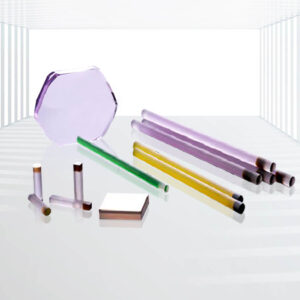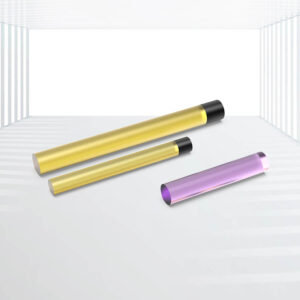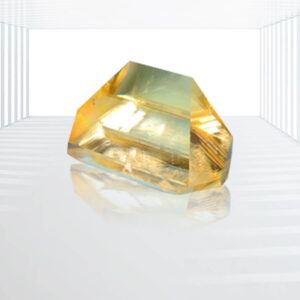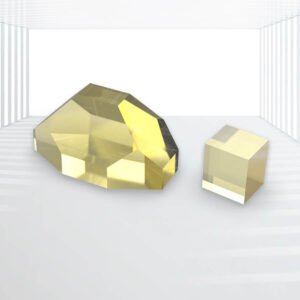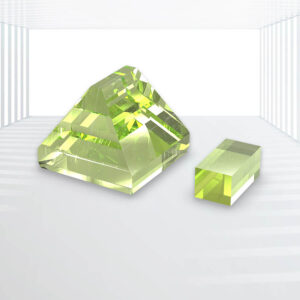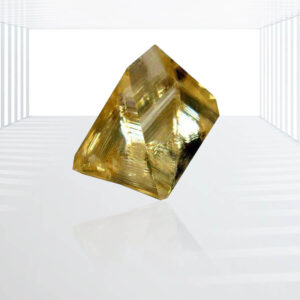Cr4+:YAG Crystals
Main Advantages: Wide Wavelength Range, Efficient Pump Absorption, High Optical Performance, Stability and Reliability, Cost-Effectiveness
Applications: Medical Lasers, Scientific Research, Industrial Lasers, Laser Radar, Telecommunications, Pulsed Laser Systems, Military and Defense, Laser Pumping
Cr4+:YAG crystals are crucial laser materials where Cr4+ ions are doped into the YAG lattice. They demonstrate outstanding optical performance and stability, making them particularly well-suited for infrared laser applications. These crystals efficiently absorb pump energy and produce stable laser output, predominantly in the wavelength range of 1.4 to 2.1 micrometers. As a result, they find extensive applications in medical, scientific research, and industrial fields, encompassing laser devices, laser radar, and materials processing.
Specifications:
| Orientation | [100] or [111] within 5° |
| Initial absorption coefficience | 0.5 ~ 6cm-1 @1064nm |
| Initial transmission | 5%~95%@1064nm |
| Sizes | Diameter:3 ~ 12mm |
| H×W:3×3~12×12mm | |
| Dimensional tolerances | Diameter:+0.00/-0.05mm |
| H&W:±0.5mm | |
| Barrel finish | Ground Finish 400# Grit |
| Parallelism | ≤ 30″ |
| Flatness | λ/8@632.8nm |
| Surface quality | 20-10(MIL-O-13830B) |
| AR coating reflectivity | ≤ 0.2% (@1064nm) |
Main Advantages:
- Wide Wavelength Range: Cr4+: YAG crystals can emit laser light over a broad wavelength range, typically from about 1.4 to 2.1 micrometers in the infrared spectrum. This versatility makes them suitable for various applications where different wavelengths are required.
- Efficient Pump Absorption: They efficiently absorb pump energy, which leads to effective conversion of input energy into laser output. This efficiency is crucial for achieving high-powered and stable laser emissions.
- High Optical Performance: Cr4+:YAG crystals exhibit excellent optical properties, such as high transparency and minimal loss, ensuring high-quality laser beams with minimal distortion.
- Stability and Reliability: These crystals are chemically and thermally stable, ensuring long-term reliability in demanding laser applications. They can withstand high-power densities and operate consistently over extended periods.
- Cost-Effectiveness: They offer a cost-effective solution for generating infrared laser pulses compared to some other laser materials, making them attractive for commercial and industrial applications.
Applications:
- Medical Lasers: Used in dermatology and ophthalmology for procedures such as skin rejuvenation, tattoo removal, and correcting eye conditions like glaucoma.
- Scientific Research: Employed in spectroscopy and microscopy for studying molecular structures and dynamics due to their ability to emit in the infrared range (1.4 to 2.1 micrometers).
- Industrial Lasers: Used in materials processing applications such as welding, cutting, and marking where precise and stable infrared laser beams are required for efficient operations.
- Laser Radar: Utilized in defense and aerospace industries for LIDAR (Light Detection and Ranging) systems to accurately measure distances and map terrain.
- Telecommunications: Used in fiber optics for amplifying signals in telecommunication networks, particularly in the infrared spectrum.
- Pulsed Laser Systems: Applied in ultrafast pulsed laser systems for generating short pulses with high peak powers, beneficial in scientific experiments and industrial applications requiring precise material processing.
- Military and Defense: Used in military applications for targeting, range finding, and laser designation due to their stable and reliable performance under harsh conditions.
- Laser Pumping: As a medium for pumping other laser materials due to their efficient absorption of pump energy and ability to generate high-energy pulses.




